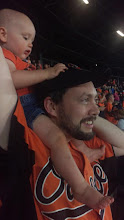 Last week, I was profiling one-and-done pitcher Dave Vineyard on my 1965 Topps blog. Despite turning in a respectable rookie season at age 23 (4.17 ERA, 50 K in 54 IP in 1964), he never pitched in the major leagues again, for Baltimore or for anyone else. There wasn't much information to be found on him, so I found myself wondering how his major league aspirations got tossed to the wayside. Arm troubles seemed to be a major culprit, but I also had a sense that a stronger O's pitching staff in 1965 could have accounted for his more immediate exclusion from the roster. After reader Mmayes chipped in with a similar comment, I decided to look up the Birds' 1965 pitching statistics. I had no idea how right I had been. Only two Oriole pitchers (Darold Knowles and Frank Bertaina) had higher ERAs in 1965 than Vineyard's serviceable 4.17 the year prior, and that pair combined to throw just 20 and two-thirds innings all year. Talk about a tough staff to crack. How tough? I'm glad you asked...
Last week, I was profiling one-and-done pitcher Dave Vineyard on my 1965 Topps blog. Despite turning in a respectable rookie season at age 23 (4.17 ERA, 50 K in 54 IP in 1964), he never pitched in the major leagues again, for Baltimore or for anyone else. There wasn't much information to be found on him, so I found myself wondering how his major league aspirations got tossed to the wayside. Arm troubles seemed to be a major culprit, but I also had a sense that a stronger O's pitching staff in 1965 could have accounted for his more immediate exclusion from the roster. After reader Mmayes chipped in with a similar comment, I decided to look up the Birds' 1965 pitching statistics. I had no idea how right I had been. Only two Oriole pitchers (Darold Knowles and Frank Bertaina) had higher ERAs in 1965 than Vineyard's serviceable 4.17 the year prior, and that pair combined to throw just 20 and two-thirds innings all year. Talk about a tough staff to crack. How tough? I'm glad you asked...Though Steve Barber led the way with just 15 wins, there was a good balance; six pitchers were double-digit winners. The only pitcher with more than five decisions to post a losing record was fifth (or sixth) starter Robin Roberts, who went 5-7 with a 3.38 ERA in 15 starts. If you're putting together a back-end of the rotation, a 38-year-old future Hall of Famer with something left in the tank is a pretty nice luxury! The superlatives go on. The five pitchers who had more starts than Roberts were all 27 years old or younger: Milt Pappas, Barber, Dave McNally, Wally Bunker, and John Miller. All had earned run averages between 2.60 and 3.38. The league average was 3.46. How about the bullpen?
So yeah, if you're giving me my pick of all-time single-season pitching staffs, Hank Bauer's bunch might just give Earl Weaver's 1971 group a run for their money. While the latter boasted four 20-game winners, the bullpen wasn't as strong as the former. Then again, with a rotation like that, who needs relievers? For the sake of argument, let's start the weekend by opening up the floor. Who else is in the running for best pitching staff ever, from top to bottom?


2 comments:
Kevin,
The first team I looked at was the 65 ChiSox. Maybe not as young as the Orioles, but very impressive, including a 22 year old Tommy John and a 42 year old (former Oriole) Hoyt Wilhelm with more impressive stats than Stu Miller (20 saves, 1.81 ERA, 0.833 WHIP in 144 innings). Hoyt would follow that with another stellar year (1.66 ERA, 0.824 WHIP). Wilhelm knuckle-balled effectively for a few more years, pitching his last game just about 2 weeks short of his 50th birthday - amazing!!
Tim - That would be a good place to look! For my part, I hope Jamie Moyer is the next Hoyt Wilhelm. He's getting close...
Post a Comment